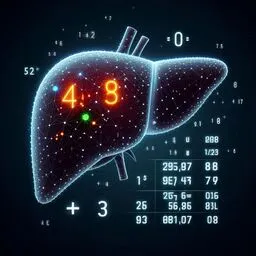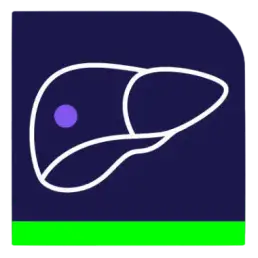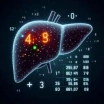Liver Volume Calculator (Ultrasound, CT, MRI)
References:
- Muggli D, Müller MA, Karlo C, Fornaro J, Marincek B, Frauenfelder T. A simple method to approximate liver size on cross-sectional images using living liver models. Clin Radiol. 2009;64(7):682-689. doi:10.1016/j.crad.2009.02.013
- Childs, J. T., Thoirs, K. A., & Esterman, A. J. (2016). The development of a practical and uncomplicated predictive equation to determine liver volume from simple linear ultrasound measurements of the liver. Radiography, 22(2), e125-e130.
- Vauthey JN, Abdalla EK, Doherty DA, et al. Body surface area and body weight predict total liver volume in Western adults. Liver Transpl. 2002;8(3):233-240. doi:10.1053/jlts.2002.31654
- Izranov VA, Ermakov AV, Martinovich MV, et al. Current possibilities of liver volume estimation in diagnostic ultrasound ( ex vivo study). Int J Radiol Radiat Ther. 2018;5(5):286-291. DOI: 10.15406/ijrrt.2018.05.00180
Related Calculators:

More About the Liver Volume Calculator
Accurate liver volume measurement is a cornerstone in diagnostic radiology and surgical planning. From hepatobiliary surgery to transplant medicine, liver size plays a pivotal role in evaluating hepatic function, determining operability, and predicting post-operative outcomes. Our liver volume calculator offers clinicians a fast, accessible, and clinically validated method of estimating liver volume using imaging-derived dimensions, without requiring complex 3D modeling or software integration. Although this tool is not affiliated with or endorsed by specific medical organizations, it is grounded in peer-reviewed methods and radiological best practices.
Why Liver Volume Matters
Liver volume provides a non-invasive estimate of hepatic functional reserve, which is essential in managing both acute and chronic liver conditions. An abnormally enlarged or shrunken liver may suggest pathology ranging from fatty liver disease and cirrhosis to hepatic malignancies or congestive hepatopathy. In surgical contexts, particularly hepatic resection and living donor transplantation, knowing precise liver volumes ensures that a sufficient liver remnant remains functional postoperatively. Underestimating or overestimating liver volume can lead to dire complications, including small-for-size syndrome or liver failure.
Clinical Scenarios That Require Liver Volume Estimation
- Living Donor Liver Transplantation (LDLT): Assessing donor and recipient liver volumes to ensure both parties maintain adequate hepatic function post-surgery.
- Hepatic Resection Planning: Ensuring that the future liver remnant (FLR) is large enough to sustain post-operative metabolism.
- Radiation Therapy: Determining the hepatic dose-volume relationship to reduce toxicity in stereotactic body radiotherapy (SBRT).
- Tumor Burden Assessment: Calculating the percentage of hepatic involvement by metastatic or primary tumors for treatment planning.
- Portal Vein Embolization (PVE): Monitoring hypertrophy of the FLR after PVE to determine surgical readiness.
Methods of Liver Volume Calculation
The liver volume calculator supports multiple estimation approaches derived from imaging modalities such as CT and MRI. These include:
- Ellipsoid Method: This simplified approach uses the formula: Volume = (length × width × height × 0.52), offering a quick, reproducible approximation. Though less precise than 3D methods, it's commonly used in clinical settings due to its efficiency.
- Manual Planimetry: A more precise technique involving contour tracing on each image slice to sum cross-sectional areas and derive total volume. It is resource-intensive but is considered a gold standard.
- Volumetric 3D Reconstruction: Advanced software solutions extract liver boundaries from imaging datasets and build 3D models for detailed analysis. While highly accurate, these methods require time, expertise, and computational resources.
Imaging Modalities for Liver Volume Assessment
Accurate volume measurements hinge on high-resolution imaging. The liver volume calculator assumes data derived from:
- CT (Computed Tomography): Especially contrast-enhanced scans in the portal venous phase, which provide excellent delineation of liver margins.
- MRI (Magnetic Resonance Imaging): Offers superior soft tissue contrast, especially beneficial in cases of steatosis or diffuse liver disease.
Improving Workflow Efficiency and Precision
In fast-paced clinical environments, rapid liver volume estimation supports timely decision-making. This liver volume calculator potentially reduces time spent on manual computations, freeing clinicians to focus on patient care. Its intuitive design ensures minimal learning curve, and it is optimized for both desktop and mobile interfaces.
Supporting Evidence-Based Practice
Although this tool is not officially sanctioned by hepatology or transplant societies, it draws from peer-reviewed methodologies and clinical consensus on liver volumetrics. Several studies have validated simplified methods like the ellipsoid formula as reliable proxies for volumetric modeling when resource constraints exist.
Integrating Into Multidisciplinary Care
Whether in pre-operative assessment clinics, interventional radiology, or oncology tumor boards, liver volume calculators are vital across specialties. The ability to rapidly assess hepatic capacity informs a wide range of management decisions, from the feasibility of resection to candidacy for liver transplantation.
Considerations and Limitations
Clinicians should be aware of potential variability introduced by patient positioning, slice thickness, and imaging phase. While this liver volume calculator minimizes user error, it should complement—not replace—clinical judgment and radiologist input. For borderline cases or high-risk procedures, 3D software-assisted volumetry remains the preferred standard.
Conclusion: Empowering Better Hepatic Care
Our liver volume calculator is an evidence-informed tool that supports clinicians in delivering safe, personalized, and efficient care. From general surgery to transplant hepatology, liver volume estimation is foundational to patient assessment. By combining convenience with scientific rigor, this calculator helps close the gap between complex analysis and clinical accessibility.




